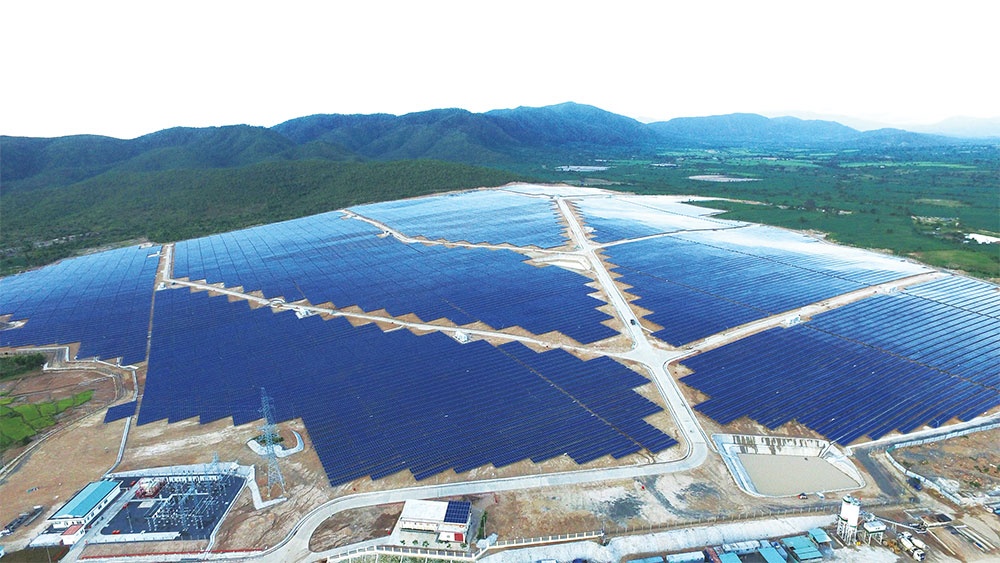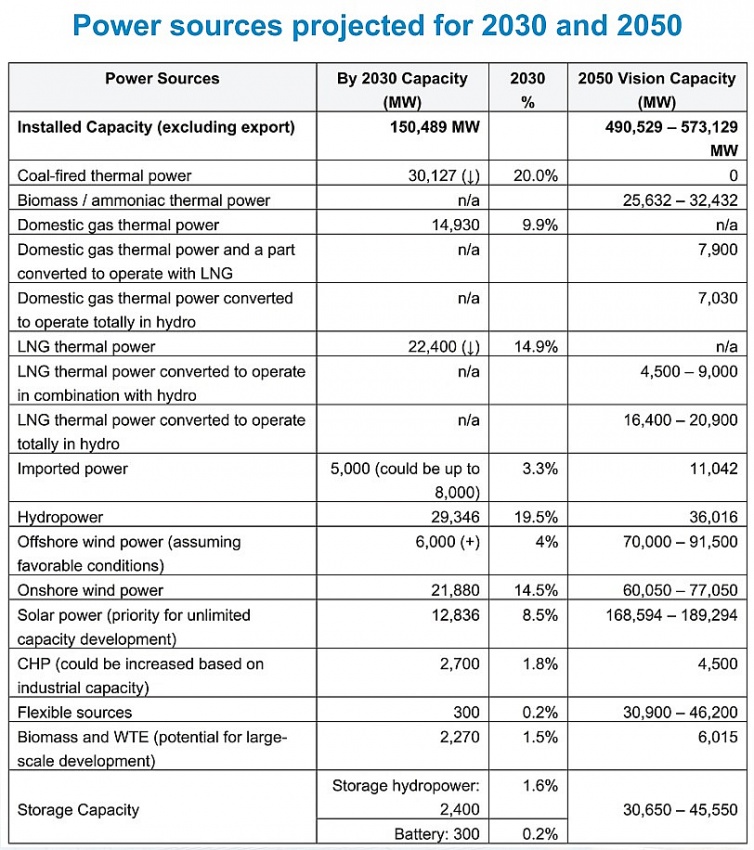Wheels begin to turn for energy plan
Right after the Power Development Plan VIII (PDP8) was approved at the end of last month, some renewable energy projects were licensed to operate at temporary prices, raising hopes for renewable electricity schemes to join the grid. The ventures included the wind farm projects of Nhon Hoi 2, Tan Phu Dong 1, Huong Linh 7, and Huong Hiep 1.
According to state-run Electricity of Vietnam (EVN), on May 31 nine out of 85 transitional renewable energy projects had submitted documents for recognition of commercial operation date (COD). In which, seven projects/phases have completed COD procedures and are officially allowed to generate commercial power on the grid, while 63/85 transitional renewable energy projects have submitted documents to negotiate electricity prices and power purchase agreements.
 |
| Wheels begin to turn for energy plan, illustration photo/ Source: Shutterstock |
For instance, after more than two years of waiting for the price mechanism for transitional projects, the remaining 114MW of Phu My Solar Power Plant was officially recognised for commercial operation on May 30.
After starting construction in May 2020, with an area of 325 hectares, the plant has the largest scale in the central region with a capacity of 330MW, funded by Bamboo Capital Group. At the end of 2020, the plant put 216MW into commercial operation and enjoys a purchase price of 7.09 US cents/kWh for 20 years.
Phu My Solar Power Plant generates about 520 million kWh/year of electricity, equivalent to the usage of 200,000 households, and helps reduce emissions by about 146,000 tonnes of CO2.
“With the approval of the PDP8, transitional projects begin to come into commercial operation, foreign investor confidence is being strengthened, and opportunities to mobilise international green credit for development have also been strengthened. Our development is expected to expand further in the near future,” said a Bamboo Capital Group representative.
Meanwhile, Deputy Prime Minister Tran Hong Ha has asked the Ministry of Industry and Trade to urgently issue specific guiding documents on pricing methods, price negotiation, and price brackets for transitional wind and solar power projects.
Along with transitional projects, the new plan could open up new prospects for investors as it mentions, for the first time, that stored electricity could account for 7.9 per cent of the total capacity of power plants by 2050.
 |
Dominic Heaton, managing director of VRB Energy in Vietnam, said, “Without this addition on electricity storage, we could not have promoted the energy transition. The government’s recognition of the importance of electricity storage will help strengthen the confidence of investors like us.”
Under the PDP8, the government is increasing the development of its energy production sector and is aware of the significance of managing electrical loads. In order to enable the widespread integration of renewable energy sources, it intends to build hydropower plants for energy storage, with a projected capacity of 2,400MW by 2030.
The plan also allows for the development of storage batteries, which, if used, would provide for an additional 300MW of energy storage by 2030 should they become more cost-effective. The nation wants to have around 30,600-45,500MW of total energy storage by 2050, including both hydropower and battery storage power facilities.
“We are making a proposal to a locality to invest in building a renewable electricity storage system that will retain excess electricity when the national grid is overloaded, then only at off-peak hours to release the amount of electricity,” said Sebastien Prioux, general director of GreenYellow Vietnam Company.
The PDP8 prioritises renewable energy, particularly offshore wind, in the long term. Vietnam aims to complete the coal phase-out by 2050, and the proportion of coal-fired power plants in the source structure will decrease from nearly 29 per cent in 2020 to 20.5 per cent in 2030. The PDP8 aims to develop renewable energy sources for electricity production vigorously. In orientation to 2050, the rate of renewable energy will be up to 67.5-71.5 per cent.
“The plan is ambitious, no doubt, and there will be cynics, but it comes not a moment too soon as the potential is undeniable,” wrote experts for Mayer Brown on its website last month. “The call to action on the energy transition is now louder than ever – and to achieve it countries are competing for foreign investment and resources, which are not limitless, and will not materialise without stable and supportive regulatory regimes.”
| Nguyen Hong Dien - Minister of Industry and Trade
The approval of PDP8 is of particular importance. It opens up a new development space for Vietnam’s energy industry towards sustainability, fairness, and in line with the viewpoints and policies of the Party and state, and the actual ability of the country – as well as international development trends such as the trend of green economy, circular economy, and low carbon economy. The PDP8 is ambitious in its objectives to provide national energy security in order to meet socioeconomic growth targets and comply with international environmental standards. It lays out the country’s plan through 2030 and has a vision for 2050. The plan seeks to increase the generation of wind and gas energy while lowering dependency on coal in order to aid Vietnam’s transition to becoming carbon neutral by 2050. It will require an estimated $134.7 billion in funding. The PDP8 aims to realise three objectives. First is to firmly ensure national energy security. The second aspect is to meet the requirements of socioeconomic development, industrialisation, modernisation of the country. Thirdly, it aims to successfully implement equitable energy transition in association with production modernisation, smart grid construction, and advanced power system management. This is all in line with the trend of the green transition, emission reduction, and sci-tech development worldwide. It also aims to form an overall energy ecosystem based on renewable energy and new energy. Hoang Quang Phong - Vice president, Vietnam Chamber of Commerce and Industry
The PDP8 will lay the groundwork for the growth of renewable energy sources. Therefore, the government must act fast to establish a framework that will let companies invest in renewable energy and meet the environmental standards, as well as completing the legal and institutional framework to facilitate the development of renewable energy, solar rooftop, and self-consumption. Rooftop solar power, in particular, is prioritised for development for self-use models to serve production,. Businesses need to have infinite capacity, at competitive rates, and take advantage. In reality, manufacturing sectors are eager to implement green certificates and run their operations on green energy to save operating expenses. The rules and recommendations for installation and investment in self-use models are still unclear,, however. Therefore, in order to achieve the objectives set out in the PDP8, it is necessary to have a confirmation mechanism. At the same time, we must discuss and amend processes and procedures, find solutions to solve problems, and have appropriate mechanisms and policies, because if there is no immediate solution, Vietnam will lose out on opportunities. |
| To support the implementation of PDP8, the Ministry of Industry and Trade (MoIT) will propose amendments to the Law on Electricity and Law on Renewable Energy, which are expected to be presented to the National Assembly in 2024. The plan also includes provisions for direct power purchase agreements between renewable energy producers and customers, with the aim of establishing a legal basis for them in the future. The MoIT will also have to work with ministries, sectors, localities, and investors to carefully review the provisions of the law, commitments, and agreements between parties to completely handle projects that are facing difficulties and report to the Prime Minister on matters beyond its competence. |
What the stars mean:
★ Poor ★ ★ Promising ★★★ Good ★★★★ Very good ★★★★★ Exceptional
Related Contents
Latest News
More News
- Schaeffler reports strong early output from Dong Nai solar project (December 12, 2025 | 15:16)
- Forestry conference highlights biodiversity and sustainability goals (December 09, 2025 | 13:35)
- Home Credit honoured among top 10 sustainable companies in trade and services (December 09, 2025 | 12:18)
- SCG and seven member companies honoured in Top 100 Sustainable Businesses 2025 (December 08, 2025 | 09:00)
- Nestlé Vietnam pioneers sustainable development and promotes business connections (December 06, 2025 | 12:09)
- CSI 2025 highlights rise of Vietnam’s green champions (December 06, 2025 | 09:00)
- Acecook Vietnam named among top 100 sustainable businesses (December 06, 2025 | 08:00)
- Vietnam’s forest carbon credits draw global interest (December 05, 2025 | 17:41)
- Coro Energy to launch BESS Pilot in Vietnam (December 04, 2025 | 15:12)
- Vietnam strengthens energy storage pathway (December 04, 2025 | 15:05)



 Tag:
Tag:






















 Mobile Version
Mobile Version